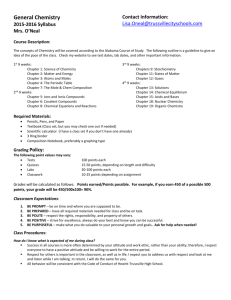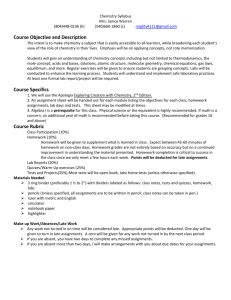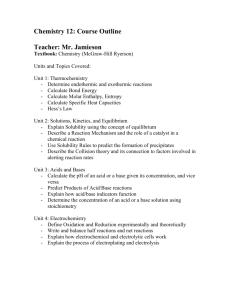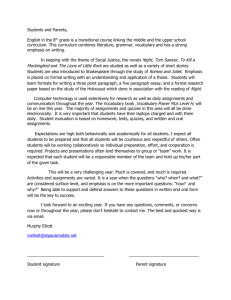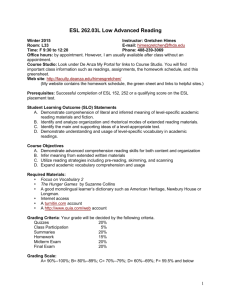here - Granite Hills High School
advertisement
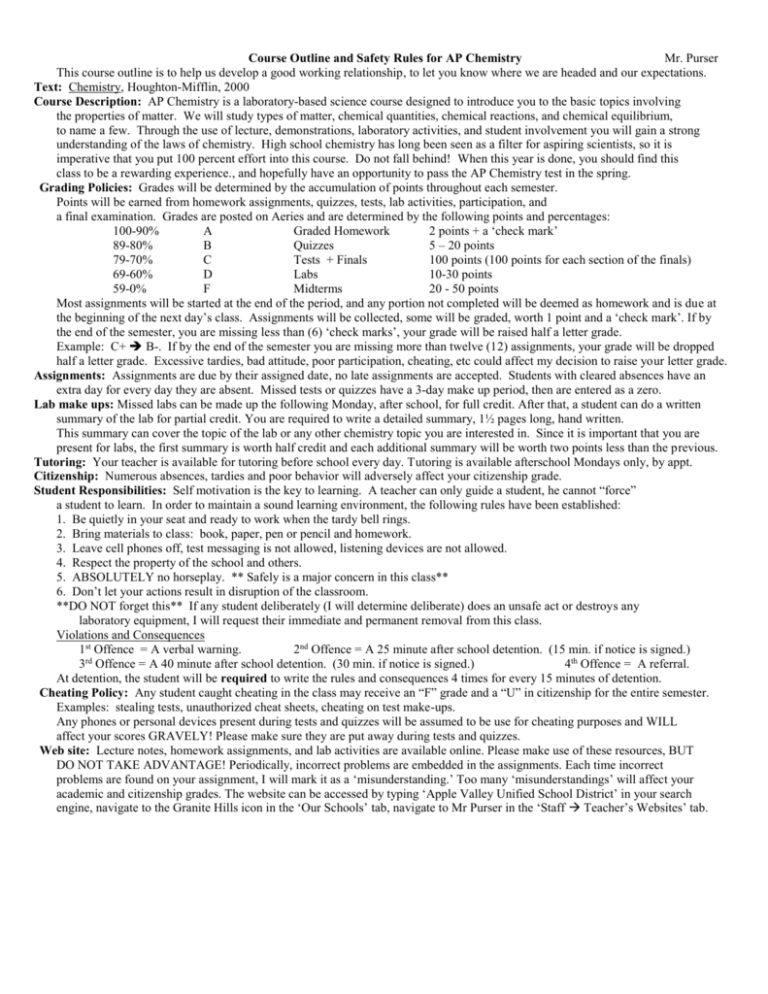
Course Outline and Safety Rules for AP Chemistry Mr. Purser This course outline is to help us develop a good working relationship, to let you know where we are headed and our expectations. Text: Chemistry, Houghton-Mifflin, 2000 Course Description: AP Chemistry is a laboratory-based science course designed to introduce you to the basic topics involving the properties of matter. We will study types of matter, chemical quantities, chemical reactions, and chemical equilibrium, to name a few. Through the use of lecture, demonstrations, laboratory activities, and student involvement you will gain a strong understanding of the laws of chemistry. High school chemistry has long been seen as a filter for aspiring scientists, so it is imperative that you put 100 percent effort into this course. Do not fall behind! When this year is done, you should find this class to be a rewarding experience., and hopefully have an opportunity to pass the AP Chemistry test in the spring. Grading Policies: Grades will be determined by the accumulation of points throughout each semester. Points will be earned from homework assignments, quizzes, tests, lab activities, participation, and a final examination. Grades are posted on Aeries and are determined by the following points and percentages: 100-90% A Graded Homework 2 points + a ‘check mark’ 89-80% B Quizzes 5 – 20 points 79-70% C Tests + Finals 100 points (100 points for each section of the finals) 69-60% D Labs 10-30 points 59-0% F Midterms 20 - 50 points Most assignments will be started at the end of the period, and any portion not completed will be deemed as homework and is due at the beginning of the next day’s class. Assignments will be collected, some will be graded, worth 1 point and a ‘check mark’. If by the end of the semester, you are missing less than (6) ‘check marks’, your grade will be raised half a letter grade. Example: C+ B-. If by the end of the semester you are missing more than twelve (12) assignments, your grade will be dropped half a letter grade. Excessive tardies, bad attitude, poor participation, cheating, etc could affect my decision to raise your letter grade. Assignments: Assignments are due by their assigned date, no late assignments are accepted. Students with cleared absences have an extra day for every day they are absent. Missed tests or quizzes have a 3-day make up period, then are entered as a zero. Lab make ups: Missed labs can be made up the following Monday, after school, for full credit. After that, a student can do a written summary of the lab for partial credit. You are required to write a detailed summary, 1½ pages long, hand written. This summary can cover the topic of the lab or any other chemistry topic you are interested in. Since it is important that you are present for labs, the first summary is worth half credit and each additional summary will be worth two points less than the previous. Tutoring: Your teacher is available for tutoring before school every day. Tutoring is available afterschool Mondays only, by appt. Citizenship: Numerous absences, tardies and poor behavior will adversely affect your citizenship grade. Student Responsibilities: Self motivation is the key to learning. A teacher can only guide a student, he cannot “force” a student to learn. In order to maintain a sound learning environment, the following rules have been established: 1. Be quietly in your seat and ready to work when the tardy bell rings. 2. Bring materials to class: book, paper, pen or pencil and homework. 3. Leave cell phones off, test messaging is not allowed, listening devices are not allowed. 4. Respect the property of the school and others. 5. ABSOLUTELY no horseplay. ** Safely is a major concern in this class** 6. Don’t let your actions result in disruption of the classroom. **DO NOT forget this** If any student deliberately (I will determine deliberate) does an unsafe act or destroys any laboratory equipment, I will request their immediate and permanent removal from this class. Violations and Consequences 1st Offence = A verbal warning. 2nd Offence = A 25 minute after school detention. (15 min. if notice is signed.) rd 3 Offence = A 40 minute after school detention. (30 min. if notice is signed.) 4th Offence = A referral. At detention, the student will be required to write the rules and consequences 4 times for every 15 minutes of detention. Cheating Policy: Any student caught cheating in the class may receive an “F” grade and a “U” in citizenship for the entire semester. Examples: stealing tests, unauthorized cheat sheets, cheating on test make-ups. Any phones or personal devices present during tests and quizzes will be assumed to be use for cheating purposes and WILL affect your scores GRAVELY! Please make sure they are put away during tests and quizzes. Web site: Lecture notes, homework assignments, and lab activities are available online. Please make use of these resources, BUT DO NOT TAKE ADVANTAGE! Periodically, incorrect problems are embedded in the assignments. Each time incorrect problems are found on your assignment, I will mark it as a ‘misunderstanding.’ Too many ‘misunderstandings’ will affect your academic and citizenship grades. The website can be accessed by typing ‘Apple Valley Unified School District’ in your search engine, navigate to the Granite Hills icon in the ‘Our Schools’ tab, navigate to Mr Purser in the ‘Staff Teacher’s Websites’ tab. Safety Regulations for Chemistry Students While working in the science laboratory, you will have certain important responsibilities that do not apply to other classrooms. You will be working with materials and apparatus which, if handled carelessly or improperly, have the potential to cause injury or discomfort. A science laboratory can be a safe place to work, if you are foresighted, alert, and cautious. The following practices will be followed: 1. Report any accident to the teacher immediately, no matter how minor, including burns, scratch, cut, or corrosive liquid on skin or clothing. 2. Perform only those laboratory activities for which instructions and permission have been given by the teacher. 3. Use only materials and equipment authorized by the instructor. 4. Follow written and verbal instructions carefully. Do not perform unauthorized experiments. 5. Wear appropriate eye protection, as directly by the instructor, whenever working in the laboratory. Safety goggles must be worn during experiments involving caustic/corrosive chemicals, heating of liquids, and other activities that may injure the eyes. 6. Prepare for each laboratory activity by reading all instructions before coming to class. Follow all directions implicitly and intelligently. Make note of any modification in procedure given by the instructor. 7. Never carry hot equipment or dangerous chemicals through a group of students. 8. Never taste anything or touch chemicals with the hands unless specifically instructed to do so. 9. Eating or drinking in the laboratory or from laboratory equipment is not permitted. 10. Always test for odor of chemicals by waving your hand above the container and sniffing cautiously from a distance. 11. Never pour reagents back into bottles, exchange stoppers of bottles, or lay stoppers on the table. 12. When diluting acids, always pour acids into water, never the reverse. Combine the liquids slowly while stirring the mixture with a glass rod. Just remember this jingle, “like ya otter … add acid to water.” 13. Keep hands away from face eyes and body while using solutions, specimens, equipment, or materials in the laboratory. Wash hands thoroughly at the conclusion of the laboratory period. Wear gloves when instructed to do so. 14. In case of a burn from an acid or alkali, wash the affected area immediately with plenty of running water. If the eye is involved, irrigate it without interruption for at least 15 minutes. Report the incident to your instructor immediately. 15. Check labels and equipment instructions carefully. Be sure correct items are being used in the proper manner. 16. Know the location of the emergency shower, eye and face wash fountain, fire blanket, fire extinguisher, fire alarm box, and exits. 17. Know the proper fire drill procedure. 18. Roll longs sleeves up above the wrist. Coats and bulky sweaters should be removed. 19. Keep work areas clean. 20. Confine long hair during a laboratory activity. 21. Light gas burners only as instructed by the teacher. 22. Do not throw used matches into waste paper baskets. A metal container should be provided for their disposal. 23. Dispose of litmus paper, wooden splints, toothpicks, and so on in the same manner as matches. 24. Use a burner with extreme caution. Keep your head and clothing away from the flame and turn it off when not in use. 25. Do not bring any substance into contact with a flame unless specifically instructed to do so. 26. When heating material in a test tube, do not look down into the tube while heating it, or point it in the direction of any students during the process. 27. Place personal items in the designated storage area. Take only laboratory manuals and laboratory notebooks into the working area. 28. Student apparel should be appropriate for laboratory work. Long hanging necklaces, bulky jewelry, and excessive and bulky clothing should not be worn in the laboratory. 29. Students are not permitted in laboratory storage rooms or teacher work rooms without the permission of the teacher. 30. Throw all solid waste in designated waste baskets, jars, or other receptacles. Do not discard any solids in the laboratory sinks, especially glass items, such as tubing or cover glasses. 31. Any science project or individually planned experiments must be approved by the teacher. 32. To cut small-diameter glass tubing, use a file or tubing cutter to make a deep scratch. Wrap the tubing in a paper towel before breaking the glass away from you with your thumbs. Fire polish all ends. 33. When bending glass, allow time for the glass to cool before further handling. Hot and cold glass have the same visual appearance. Determine if an object is hot by bringing the back of your hand up close. 34. Remove all broken glass from work area or floor as soon as possible. Never handle broken glass with bare hands; use a brush and dustpan. Report broken thermometers to the instructor immediately. 35. When removing an electrical plug from its socket, pull the plug not the electrical cord. 36. Always approach laboratory experiences in a serious and courteous manner. 37. Hazardous or toxic liquids should be disposed of properly. Follow the directions of your instructor. (Please detach and return this portion.) I have read the AP Chemistry course outline and safety rules. I understand them and will abide by them. _____________________________ (Student Name) _______________________________________ __________________ (Student Signature) (Date) ____________________________________________ (Parent’s or Guardian’s Signature) ______________ (Period)
